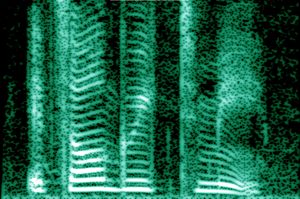
Back Stem Afrikaans صوت الإنسان Arabic Tingog BCL Чалавечы голас Byelorussian Глас Bulgarian মানব কণ্ঠস্বর Bengali/Bangla Veu Catalan Hlas Czech Llais Welsh Menschliche Stimme German

The human voice consists of sound made by a human being using the vocal tract, including talking, singing, laughing, crying, screaming, shouting, humming or yelling. The human voice frequency is specifically a part of human sound production in which the vocal folds (vocal cords) are the primary sound source. (Other sound production mechanisms produced from the same general area of the body involve the production of unvoiced consonants, clicks, whistling and whispering.)
Generally speaking, the mechanism for generating the human voice can be subdivided into three parts; the lungs, the vocal folds within the larynx (voice box), and the articulators. The lungs, the "pump" must produce adequate airflow and air pressure to vibrate vocal folds. The vocal folds (vocal cords) then vibrate to use airflow from the lungs to create audible pulses that form the laryngeal sound source.[1] The muscles of the larynx adjust the length and tension of the vocal folds to 'fine-tune' pitch and tone. The articulators (the parts of the vocal tract above the larynx consisting of tongue, palate, cheek, lips, etc.) articulate and filter the sound emanating from the larynx and to some degree can interact with the laryngeal airflow to strengthen or weaken it as a sound source.
The vocal folds, in combination with the articulators, are capable of producing highly intricate arrays of sound.[2][3][4] The tone of voice may be modulated to suggest emotions such as anger, surprise, fear, happiness or sadness. The human voice is used to express emotion,[5] and can also reveal the age and sex of the speaker.[6][7][8] Singers use the human voice as an instrument for creating music.[9]
- ^ "About the voice". Lionsvoiceclinic.umn.edu. Retrieved 8 February 2018.
- ^ Stevens, K.N.(2000), Acoustic Phonetics, MIT Press, ISBN 0-262-69250-3, 978-0-262-69250-2
- ^ Titze, I.R. (1994). Principles of Voice Production, Prentice Hall (currently published by NCVS.org), ISBN 978-0-13-717893-3.
- ^ Titze, I. R. (2006). The Myoelatic Aerodynamic Theory of Phonation, Iowa City:National Center for Voice and Speech, 2006.
- ^ Johar, Swati (22 December 2015). Emotion, Affect and Personality in Speech: The Bias of Language and Paralanguage. SpringerBriefs in Speech Technology. Springer. pp. 10, 12. ISBN 978-3-319-28047-9.
- ^ Bachorowski, Jo-Anne (1999). "Vocal Expression and Perception of Emotions" (PDF). Current Directions in Psychological Science. 8 (2): 53–57. doi:10.1111/1467-8721.00013. S2CID 18785659. Archived (PDF) from the original on 9 October 2022.
- ^ Smith, BL; Brown, BL; Strong, WJ; Rencher, AC (1975). "Effects of speech rate on personality perception". Language and Speech. 18 (2): 145–52. doi:10.1177/002383097501800203. PMID 1195957. S2CID 23498388.
- ^ Williams, CE; Stevens, KN (1972). "Emotions and speech: some acoustical correlates". The Journal of the Acoustical Society of America. 52 (4): 1238–50. Bibcode:1972ASAJ...52.1238W. doi:10.1121/1.1913238. PMID 4638039.
- ^ Titze, IR; Mapes, S; Story, B (1994). "Acoustics of the tenor high voice". The Journal of the Acoustical Society of America. 95 (2): 1133–42. Bibcode:1994ASAJ...95.1133T. doi:10.1121/1.408461. PMID 8132903.
© MMXXIII Rich X Search. We shall prevail. All rights reserved. Rich X Search